Note: This publication is currently undergoing major revisions. The current publication will be replaced with a new publication based on stakeholder requirements and scientific advances. We expect to begin sharing details on this soon. If you have input on content, format, or publication frequency at any time, please contact us at cbrfc.webmasters@noaa.gov.Upper Colorado Water Supply Outlook, February 1, 2009Upper Colorado Water Supply Outlook, February 1, 2009
Contents
Upper Colorado Summary
There was a large discrepancy in the January precipitation between the northern half of
the Colorado River Basin and the southern half. The Upper Colorado Basin had 120% of
average precipitation during the month, while the Gunnison Basin had 80% and the Dolores
Basin had just 55% of average. The February 1st snow water equivalent percent of average
decreased from January 1st in the Gunnison and Dolores basins but is still above
average, as it is in the Upper Colorado.
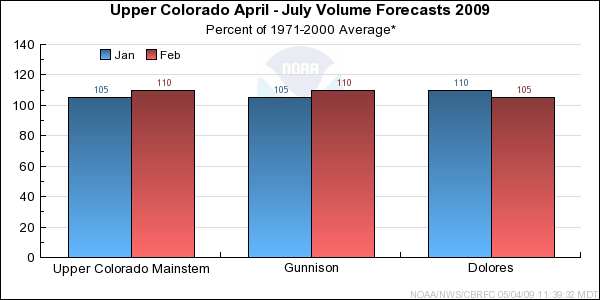
*Median of forecasts within each basin.
Upper Colorado Mainstem Basin Conditions
-Model Soil Moisture/Observed Streamflow...
Soil
moisture was near to above normal in the Upper Colorado heading into the winter.
January streamflow was near normal.
-Snowpack/Precipitation... January precipitation was 120% of average in the Upper
Colorado River Basin keeping the water year precipitation at 110% of average.
The basin wide February 1st
snow
water equivalent percent of average also held
steady, as compared to January 1st, at 125% although some individual sub-basins
did see changes. The
Muddy
Creek basin, which includes Wolford Mountain Reservoir,
had the greatest gain in the snowpack and is now over 110% of average, compared to
less than 90% of average at the beginning of January. On the flip side, the
Mill
Creek basin in Utah near the Colorado border had a decrease of over 30% of average
in its snowpack from last month. The
Roaring
Fork basin snow water equivalent
percent of average decreased by about 10% from last month, but is still the highest
in the Upper Colorado Basin at over 130% of average.
-General Discussion... Changes to the April through July streamflow volume
forecasts from last month generally corresponded to the changes in the snowpack.
Muddy Creek had the biggest increase going from 92% to 103% of average and Mill
Creek had the biggest decrease going from 106% to 96%. The rest of the forecast
volumes remained the same or were increased up to 5% over last month's forecasts
reflecting changes in snow water equivalent. The April through July streamflow
volume forecasts now range between 96% and 116% of average, with a median value of 110%.
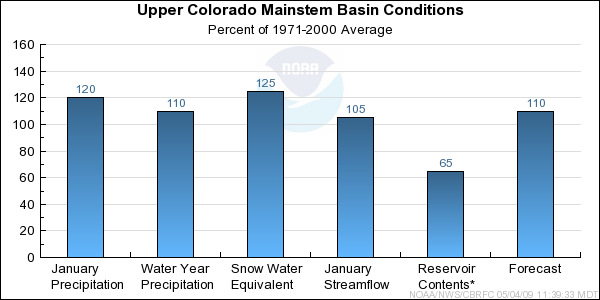
* Percent usable capacity, not percent average contents.
Click for multi-month Graph.
Gunnison Basin Conditions
-Model Soil Moisture/Observed Streamflow...
Soil moisture
for most of the upper basins in the Gunnison was near to slightly below average in the fall. Observed
streamflow for the month of January was average for the Gunnison.
-Snowpack/Precipitation...Precipitation over the Gunnison Basin as a whole
for January was below average at 80 percent. However, the northern portions
of the basin were near average while the southern portions were much below
average. As a result, the February 1st
snow
water equivalent
percent of averages changed very little from the January 1st values in the East River and North Fork
Gunnison drainages, and dropped 5-10 percent in the Tomichi and Lake Fork
drainages. Seasonal precipitation for the Gunnison is 110 percent of average
and overall snow water equivalent remains above average at 115% of average.
-Short Term Precipitation Forecast...The forecast models through the first week of February keep the Gunnison Basin
relatively dry with slighly above average temperatures.
-General Discussion...The
CPC guidance shows
the possibility of above average precipitation and below normal temperatures for the secound week of February.
However, for February through April, CPC suggests a chance for above average temperatures and below average
preciptation. Due to the average soil moiture in the upper basin this fall and the combination of current
snowpack conditions and the CPC forecast, the median April-July forecast for the Gunnison Basin is 110 percent of
average. This is up 5 percent from last month's forecast due to the average January precipitation
and steady snowpack across the northern portions of the Gunnison.
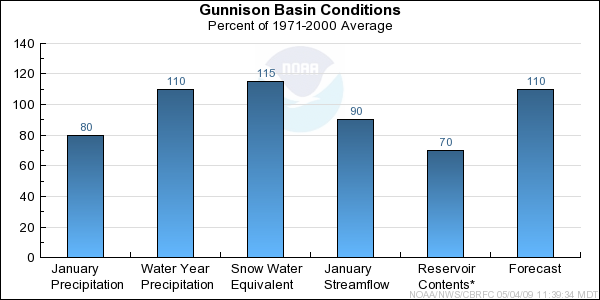
* Percent usable capacity, not percent average contents.
Click for multi-month Graph.
Dolores Basin Conditions
-Model Soil Moisture/Observed Streamflow...
Soil moisture
for most of the upper basins in the Dolores was below average in the fall. This was most likely due to
limited monsoonal precipitation during the summer months. Observed streamflow for the month of January was
mostly below average for the Dolores.
-Snowpack/Precipitation...As of February 1st,
snow water equivalents
across the Dolores were currently 120 percent of average. Precipitation over the Dolores Basin for
January was much below average with 55 percent. Seasonal average precipitation for the Dolores Basin is average with 100 percent.
-Short Term Precipitation Forecast...The forecast models through the first week of February keep the Dolores Basin
relatively dry with above average temperatures.
-General Discussion...The
CPC guidance
shows the possibility of above average precipitation and below normal temperatures for the secound week of February.
However, for February through April, CPC suggests a chance for above average temperatures and below average
preciptation for the Dolores Basin. Due to the below average soil moiture in the upper basin this fall and the
combination of current snowpack conditions and the CPC forecast, the median April-July forecast for the Dolores Basin
is 105 percent of average.
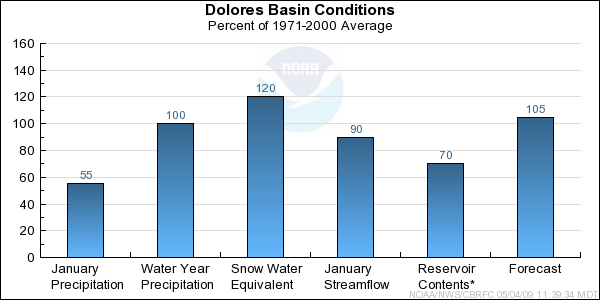
* Percent usable capacity, not percent average contents.
Click for multi-month Graph.
Differences between the full period forecasts and the residual forecasts may not exactly equal the actual observed volumes due to rounding conventions (see Definitions section).
Reservoir Monthly Inflow Forecasts


Monthly Streamflows

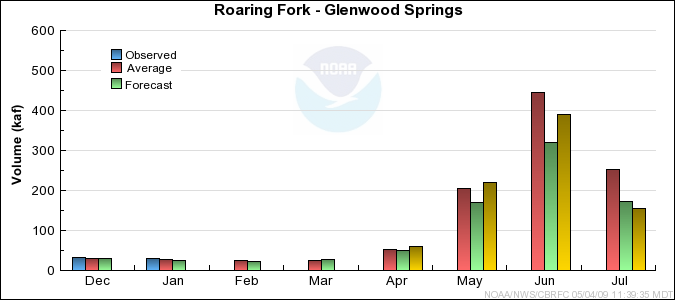
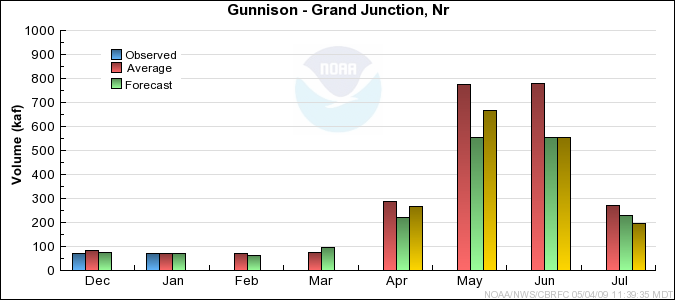
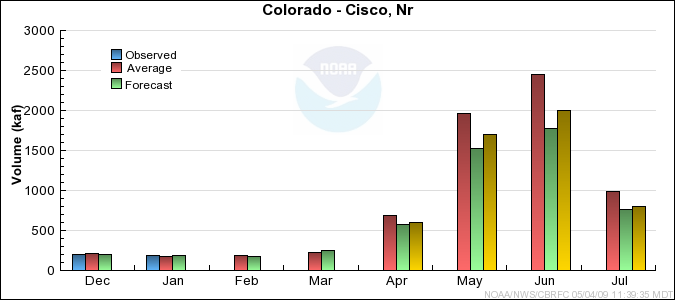
Precipitation Maps
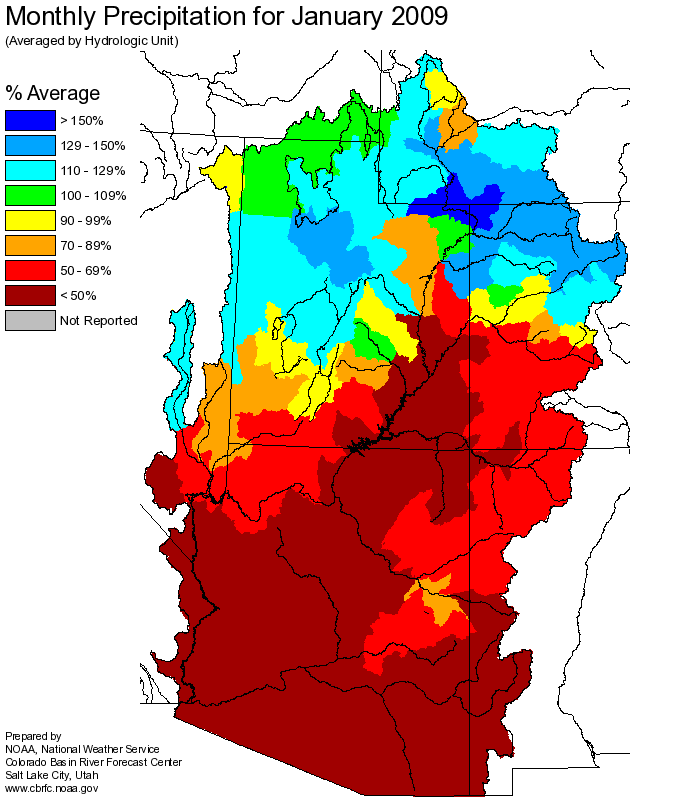
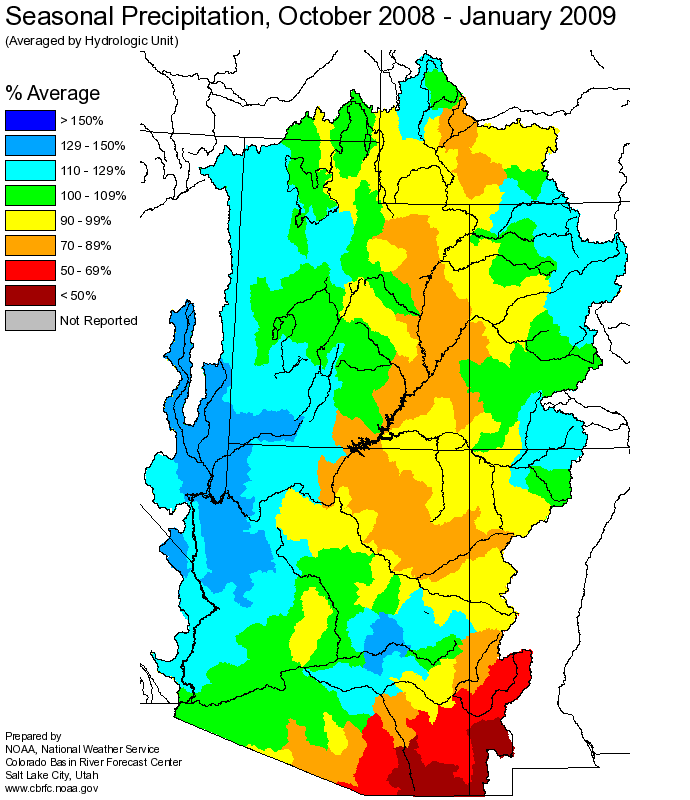
Hydrologist: Brenda Alcorn, Tracy Cox













